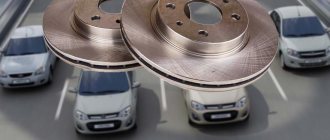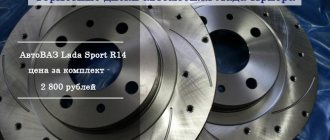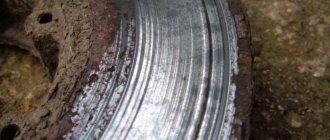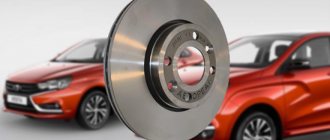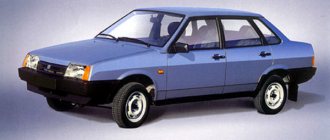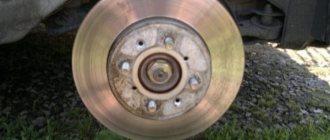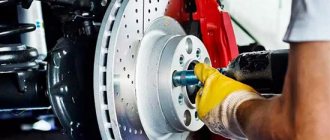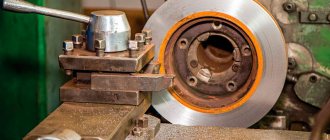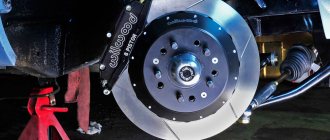The brake discs on a Priora car, like any other, are an important part of the front suspension, which is the first to begin braking. There are two options for wheels on Priora - regular factory ones and ventilated ones.
The design of the Lada Priora brake system is such that “drums” are installed at the rear, and calipers at the front. This has been going on since 2101. However, it is possible to modify the rear brakes - that is, install brake discs with calipers and backwards, instead of drums. Spare parts for the brake system on Priora must be purchased and installed by the owner on time - the safety of travel depends on their “freshness”. The ventilated front disc has an advantage over a regular one; it is lighter and has plenty of holes, which means it cools down faster! The Priora, of course, brakes well in stock, but until you have driven a Ford or Kia, disc brakes are better there. The price of ventilated brake discs for a Lada Priora car starts from 4,000 thousand rubles and above, standard ones are cheaper than 1,100. In three years, my factory production has reached 2 millimeters.
Remember that the price of these spare parts is incomparable to the damage that you may incur if the braking time increases due to wear and tear of the components. Replacement must be done on time. On the Priora, front brake discs are installed in all trim levels, but the rear ones are a subject of tuning for daring car owners.
Signs
What symptoms can be used to determine that the brake discs on a Priora need to be replaced? The main sign of wear and tear is the behavior of the car. If the working surface of the brake disc is deformed or worn, it will “cling” when you press the pedal. Also, when the pads are activated, a strong grinding noise is possible (not to be confused with the squeaking of the friction material itself). If there is a crack, braking is accompanied by beating against the steering wheel. The friction lining touches the slightest shoulders and other irregularities on the working surface of the disk.
As a result, its material crumbles and you feel increased vibration. It can be transmitted not only to the steering wheel, but throughout the body. Depends on the severity of wear or amount of deformation. In this case, it is recommended to carry out a visual inspection of the element. If there are no visible cracks, remove the wheel and run your finger along the working surface of the disc. If you feel unevenness, this means that the element has overheated and, due to expansion and contraction, has become deformed. It is worth noting that the steering wheel can only wobble when you press the pedal. If this symptom occurs while driving, your wheels may be unbalanced or one of the weights has fallen off. Often these vibrations increase as speed increases.
Obvious advantages of our store
1. Free delivery of orders over 15,000 rubles
2. Cumulative discounts up to 10%
3. Easy to order, easy to pay, easy to pick up
4. We do not limit you in choosing a transport company
5. We transfer fees With us you can pay only for the selected product
Many cars have front brakes with disc brakes and rear brakes with drum brakes. But there are exceptions to this rule, and not only in auto racing, where all 4 wheels are equipped with disc brakes for the sake of reliability. Manufacturers in other countries equip only budget modifications of cars with drum systems; most of them have all disc brakes. But is it possible to equip a domestic car, for example, a Priora, with rear disc brakes and which ones are better?
About the groove
Is it wise to repair your brakes? "Priora" is a relatively inexpensive car, but the cost of turning old discs is up to 75 percent of the cost of new elements. In addition, this restoration method is ineffective for serious deformations in the form of cracks and large wear (the thickness of the working surface is less than 6 millimeters). Reviews from motorists say that a smart decision would be to buy a new set of wheels. When old ones clear up, there is a high probability of repeated symptoms. After a couple of thousand kilometers, such a car begins to vibrate again, and the brakes become less informative. Moreover, it makes no difference whether the groove was performed on the removed element or directly on the hub. If you want to be sure of your safety, install new brake discs on your Priora. Which ones are better to choose - we will consider further.
Removal and installation process
- So, the first thing you need to do is tear off the front wheel mounting bolts, then jack up the car and finally unscrew them.
- Then remove the wheel completely.
- Then unscrew the two guide pins using a 7-mm socket and a wrench
- Knock off the brake disc using a hammer or a special puller from the hub
- During installation, it is advisable to apply copper grease to the contact points between the disk and the hub, thereby reducing future vibration and sticking of parts
You can see more detailed information on replacing brake discs on a Lada Priora in the video clip below.
Please note that in the video the caliper is dangling in a suspended state. Fortunately, it needs to be fixed so as not to damage the brake hose. In my case, all the parts will be disassembled, so the hose is not particularly valuable.
| Ventilated brake discs of the Lada Priora change as they wear out, when the thickness of one of the discs becomes less than the minimum allowable 17.8 mm. Do you know how to replace brake discs with new ones? |
Non-ventilated
These are the simplest brake discs that are installed on the basic configurations of Lada Priora cars. It is believed that this type has an outdated design and is practically not used on modern machines. Foreign manufacturers installed non-ventilated discs back in the 90s of the last century. Starting from the “zeros”, even the budget class was equipped with ventilated elements.
The disk itself is a round blank with a thickness of 10 to 20 millimeters. It is often made by casting - it is one continuous element. More expensive analogues have a collapsible design. They can change the working surface. But their price is several times higher than the cost of brake discs on a Priora of the usual cast type. The range ranges from one and a half to seven thousand rubles. The “budget” niche is occupied by non-ventilated disks due to their simple design.
Disc brakes on VAZ-2170 cars
Even at the dawn of the automotive industry, much attention was paid to the braking system of the car. Many types of brakes have been proposed. Until relatively recently, the drum system was considered a fairly reliable system.
But, with the advent of powerful engines and high speeds in our lives, they were replaced by disc brakes. This braking mechanism is much more effective, although the brake pads have a much smaller area. Due to the uniform fit of the pads to the flat disc, the greatest effect is achieved. Unlike drum brakes, in which the pads are pressed unevenly against the walls of the drum.
Disc brakes are much better at cooling. They are not filled with dirt, dust and other undesirable components that impair braking. Replacing pads on such brakes is much easier than on drum brakes. The entire system is much more compact, lighter and much cheaper than its predecessor.
Perforated
These elements have a more complex structure. The design combines two thin metal disks 5 millimeters thick. Between them there are so-called channels through which air flows. Thanks to such ventilation, the operating temperature of the disk is reduced by one and a half to two times. And as we know, when braking, a friction force arises, which is converted into thermal energy. Disks require high-quality heat dissipation.
If it is not there, the metal will overheat. As a result, we get literally crooked disks, and possibly cracked ones. The braking distance is also reduced. Compared to non-ventilated analogues, it is 15 percent lower. In addition, the service life of the brake pads increases, since the friction material no longer operates under critical temperature loads.
Captain-Smollett › Blog › VAZ front drive brakes
This article will help answer all the questions about switching from one brake to another. It will also help you figure out what kind of brakes you currently have. To do this, consider the stock front brakes for front-wheel drive VAZ: 2108-21099, 2110-2112, 2113-2115, Kalina, Priora, Granta
R13 not ventilated. Installed on the SAMAR and SAMAR-2 families, as well as on the 10th family (only with an 8-class carburetor engine). Explosion diagram Caliper
Visually, they can be distinguished by the lack of ventilation on the brake discs, in addition to the characteristic 2108 boot.
Full size General view of the R13 non-ventilated brakes
Here you can see a brake disc without ventilation and a boot
R13 ventilated Installed on families 10, Kalin, Grant exclusively with 8kl. engine. Explosion diagram Caliper
Visually, it is easy to distinguish from 08 by its wider ventilated disk. Brakes from R14 can be visually distinguished by the brake disc boot ratio.
Full size As you can see in the photo, the boot has a larger radius (it is 14
Full sizeAnd here you can clearly see the ventilation on the brake disc
R14 ventilated Installed on families 10, Prior (even with 8kl. ICE), Kalin, Grant with 16kl. engine. Explosion diagram Caliper
Visually it is easily determined by the ratio of the brake disc boot. The disc will completely cover the boot. There is another option, remove the fixed bracket and 2112 should be stamped on it. In addition, it is simply impossible to install wheels of 13 radius.
Full size Disc completely covers the boot. movable and fixed brackets R14R14 close-up brackets with numbers
R15 ventilated Installed on the Kalin and Grant families with 16kl. engine in the sport version. Explosion diagram Standard R13″ ventilated calipers are used (movable caliper 2110, fixed caliper 2110 which is machined to fit a wider brake disc).
And to extend the guide to a larger radius, the plant uses “bone” adapters
When installing them, you need to file the ears on the fist
There is another option that is almost factory-made. Install the Volga calipers using a special spacer. They have their own brake pad, which, in addition to everything, has an even larger area compared to the VAZ one.
Spacers for Volga calipers
RESULT: 1) When moving from R13 non-ventilated to R13 ventilated, you will need: - Caliper bracket 2110 movable 2110-3501017 - Caliper bracket 2110 fixed 2110-3501155 - Brake disc housing right VAZ-2110 (14 inches) 2112-3501146 - Brake disc housing left VAZ-2110 (14 inches) 2112-3501147 — Brake disc VAZ 2110 (13 inches) 2110-3501070 As you can see, we will need brackets, boots and the brake discs themselves. You can leave the old calipers.
2) When moving from R13 non-ventilated to R14 ventilated, you will need: - Caliper bracket 2110 movable 2110-3501017 - Caliper bracket 2112 fixed 2112-3501155 - Brake disc housing right VAZ-2110 (14 inches) 2112-3501146 - Brake disc housing left VA Z -2110 (14 inches) 2112-3501147 — Brake disc VAZ 2112 (14 inches) 2112-3501070 As you can see, we will need brackets, boots and the brake discs themselves. You can leave the old calipers.
3) When switching from R13 ventilated to R14 ventilated, you will need: - Caliper bracket 2112 fixed 2112-3501155 - Brake disc VAZ 2112 (14 inches) 2112-3501070 As you can see, we only need a movable bracket and the brake discs themselves. The calipers can be left as old, the boots were originally designed for R14 brakes, the movable caliper remains the same.
Some facts
Initially, perforation appeared on sports cars. The working part of the brake disc was drilled using special equipment. The result was through holes and grooves through which air circulated from the center outward. A few years later, perforation began to be used on ordinary civilian cars. But, despite such popularity, the price of such discs has not decreased at all, since the production technology has remained the same. In addition, high precision work is required. At the slightest discrepancy with the standard, such a disc is rejected and does not go on sale.
Original or analogue?
This is what AvtoVAZ writes about the original LADA brake discs.
Original brake discs meet high LADA standards and guarantee quality, for this:
- Each batch of brake discs undergoes random inspection and checks of the metal structure using special equipment, excluding porosity and other casting defects
- The disc is made from high-quality cast iron, which guarantees no warping effect during sudden braking or overheating.
- Brake discs undergo high-precision processing to ensure the absence of runout and imbalance
- All original LADA spare parts undergo numerous tests confirming the reliability and quality of each part.
About braking efficiency
When the pads come into contact with the disc, gases are formed (boundary layer), which prevent good adhesion of the friction material to the working surface. Thanks to the presence of grooves, they are easily removed. In the case of non-ventilated discs, these gases continue to slide across the metal, preventing the pads from working properly. As a result, the braking distance increases. As we have already said, preformation allows you to reduce its length by 15 percent. 100% adhesion is ensured between the metal of the disc and the working surface of the pad. In some cases, in addition to holes, grooves are used. They have a depth of about two millimeters and are directed towards the rotation of the disk. The grooves clean the working surface well of accumulated dirt, sand and other deposits that have formed there when the car was driven. In the absence of perforation, this dust settles deeply on the surface of the disc. This causes a squeaking sound when braking. The driver cannot understand the cause of the malfunction, especially if the pads have recently been replaced.
What to choose in the end?
What kind of front brake discs should I put on the Priora? Reviews from motorists agree on one thing - it all depends on the driving style. If you prefer an aggressive style, with sharp acceleration and braking, the presence of perforations and grooves is simply necessary for you. But if the car is used for leisurely driving, there is reason to think about installing non-ventilated discs. A compromise option is to purchase ventilated discs without perforation, but with grooves.
This is the average price range - from 3 to 5 thousand rubles per unit. This way you will be confident that the system is working properly and ensure maximum driving safety by reducing the braking distance by several meters. Plus, if these are alloy wheels, these grooves will give your car more sportiness.
How much do standard brake discs cost on Priora - article number and price
The front braking system of the Lada Priora car consists of several parts - very close to the discs there are several more parts that are also important for proper braking, and the other part of the suspension is responsible for a smooth ride and minimizing jumps when passing obstacles. Before buying brakes for a Priora, inspect all the parts so that they do not wear out - if they are worn out, new rotors may not save you.
The standard part for the VAZ-2170 “migrated” from the tenth family, and therefore you can often find it in stores with the inscription “for the VAZ-2112”. Its catalog number is 2112-3501070-02, the price is from 1100 to 1500 rubles.
Original and fake
Now there are a huge number of fakes on the market, which are sold under the famous brands Zimmerman, ATE, Bosch and Brembo. It is quite easy to distinguish an original from a copy. First of all, this is the thickness of the disk. If it is less than one centimeter, most likely you have a copy in your hands. Reviews from motorists recommend paying attention to the junction of the two parts of the disk. The internal grooves should connect smoothly to the work surface.
If there is a strict 90 degree angle, such discs will simply crack. Well, the last factor is the price. It is two to three times lower than the original. Compare the cost of the same model at different retail outlets. If it is significantly different, and the disc has different weights, one of the stores is selling a fake.
What's next?
First, put the car on the handbrake and put the anti-roll bars back. Next, use a wheel wrench to remove the wheel bolts and jack up the front part. Remove the wheels and unscrew the brake fluid reservoir. Using a vacuum syringe, pump out some of it into a previously prepared container until the level in the tank drops to half. This way we will prevent it from getting on the pads when dismantling them. Next we need a thick minus screwdriver. We install it between the outer brake pad and the caliper and pull back the piston. It is important not to damage it - for this reason, work extremely carefully. Then we take the “13” key in our hands (you can take a horn or ratchet) and unscrew the lower mounting bolt. If there is a locking bracket, turn it with a screwdriver or bend it with a chisel and hammer. Using the “17” key, we tighten the rotary pin.
We lift the bracket, take out the pads, remove the two bolts going to the caliper and use the “7” key to unscrew the disc itself. Then you can install new brake discs on the Priora. Assembly is carried out in reverse order.
Replacement steps
The entire replacement process can be divided into several stages:
- Removing wheels;
- Removing the old brake pad;
- Frame disassembly;
- Cleaning the hub and checking it;
- Removing coating from new disks;
- Runout check;
- Installation of new brake system elements.
Now let's talk about this in more detail.
Removing the wheel
In fact, dismantling the wheel for subsequent replacement of the brake elements is not difficult.
But a certain sequence of actions will have to be followed.
- Place a jack under the car.
- Lift it up so that it doesn't tip over, but still allows you to easily remove the wheels.
- Unscrew the wheel fasteners.
- Remove the hubcaps and the wheels themselves.
As you can see, the procedure is really simple, but it requires attention and accuracy.
Removing the pads
- Try to move the piston as far as possible from the brake mechanism. But do not exceed the distance beyond that which will allow you to comfortably remove the brake pads.
- Take out the block.
- To make the job easier, you can disassemble the brake frame. To do this, unscrew the two bolts securing the block and disconnect the device.
Hub
It must be cleaned, since all accumulated debris, dirt, and rust will negatively affect the effectiveness of the new brakes.
Dirty
For cleaning, alcohol-based solvents and metal brushes are used. If cleaning is not performed, the operation of the brakes will be accompanied by beating - this should absolutely not be allowed.
Be sure to check the hub for runout. Normally it does not exceed 0.1 mm. There is a special tool for checking. If the indicator is within normal limits, then a full assembly is performed.
Working with new disks
Many owners of the “Ten” are interested in which brake discs are best to choose for the VAZ 2110. The question is quite logical.
Choose certified replacements from reputable manufacturers such as Bosch, or stay true to factory parts. These are the two best options in terms of quality and compliance with the car itself.
New
Some take similar discs that partially fit the “ten”, sharpen them, and adjust the design. This is a dubious undertaking, since it requires serious skills in such a matter, additional time and financial costs. At the same time, it is far from a fact that such brakes will work better than those offered by the AvtoVAZ plant.
You've already figured out how to remove the brake element, so it's time to work on a new one. It’s not enough to just buy another brake disc and put it in place. First, it is prepared and a runout check is performed. Let's talk about this in more detail.
- The coating must be removed from a new disc.
- This coating serves as a kind of preservative.
- The layer is removed using any solvent.
- Clean thoroughly and wipe the part dry after finishing work.
- Now you can put the disk in a new place and check the runout.
- The permissible runout is no more than 0.15 millimeters.
- If the value is exceeded, this can lead to an increase in the sensitivity of the brake pedal, as well as the formation of vibrations during braking.
Adviсe
When replacing a disc, new pads should be installed. This is a required step. Some manufacturers include a pair of new pads when purchasing a disc. Also maintain symmetry. Let's say your disk is cracked and you buy one standard “replacement” one. If you install a new one on only one side, there will be uneven distribution of braking forces and asymmetrical wear. The same goes for the pads. They only change in pairs. Also, when replacing, pay attention to the condition of other parts - caliper boots, guides. If there are any gaps or signs of deformation/wear, replace them. After the brake discs have been successfully installed on the Priora, add fluid to the reservoir and bleed the system. The presence of bubbles in it is unacceptable - braking on such a car becomes ineffective. The liquid simply boils from the compression of air.
How to remove the Priora caliper
You will need: remove the front wheels and prepare a 17mm spanner. Procedure:
- Unscrew the two bolts securing the shoe guide to the steering knuckle using a 17mm wrench.
- Remove the pad guide from the disc along with the bracket and pads.
- Make sure that the brake hose is not stretched; to do this, tie the caliper to the suspension spring.
If you have to unscrew the working cylinder from the tip of the brake hose, then you should close the hole in the hose in any way so that the brake fluid does not leak out.
Installing the Priora caliper is done in the reverse order. Check that the brake hose is not kinked. After installation, do not forget to check the brake fluid level in the reservoir and remove air from the brake system.
About the resource
The replacement period for this element directly depends on your driving style. The more often you accelerate and brake, the lower the resource of the node. Factory brake discs installed on Priora can withstand up to two hundred thousand kilometers. But with aggressive driving, this period can be less than one hundred thousand. If possible, brake in gear and switch to neutral in advance before a red traffic light. Use more “rolling” - this will not only preserve the discs and pads (the latter are changed every 25 thousand kilometers), but will also increase the service life of the gearbox. Fuel savings are also significant.
So, we found out how to choose the right brake pads and install them on a Lada Priora car with our own hands.
Manufacturers
There are several popular manufacturers of brake discs on the market for various car models:
- TRW is a well-known manufacturer of brake discs for various makes and models of cars. They are considered a fairly good manufacturer, with decent declared characteristics. In terms of price/quality ratio, it is one of the best on the market. According to their characteristics and dimensions, they are well suited to domestic cars and budget foreign cars (Lada Kalina, Priora, Granta, Hyundai Accent). The average cost of a set is about 4,000 rubles. The manufacturer’s line includes both conventional and products with perforation and ventilation;
- Bosch is a famous German manufacturer of automotive components. Its products are deservedly considered one of the best on the market, due to the use of a strict quality control system. These are perfect for models - Chevrolet Lacetti, Mitsubishi Lancer and other C class models. In terms of their characteristics, they are in no way inferior to famous and sporty models. The range includes all types of brake discs. The average cost is about 7,000 rubles. The main problem when choosing and purchasing such discs is the large number of counterfeit products on the market. On the official website of the manufacturer you can see information about original products and completely protect yourself;
- Brembo - this manufacturer stands out from the general range of competitors. The products are considered premium products and are installed on expensive sports car models. According to its characteristics, it will give a head start to any competitor. They are distinguished by excellent adhesion properties, high resistance to overheating when working in extreme conditions and excellent endurance. The cost of the kit directly depends on the model. The starting price is about 35,000 rubles. According to the results of numerous ratings, they invariably occupy leading positions;
- Otto zimmermann is a well-known German manufacturer of high-quality brake discs. Known for its products for several decades. The main distinguishing feature of the products is consistently high quality and excellent wear resistance during long-term use.
The product line is diverse and includes various modifications for car models. The cost of the kit depends on the modification and model of the machine. The average price is about 8,000 rubles.
